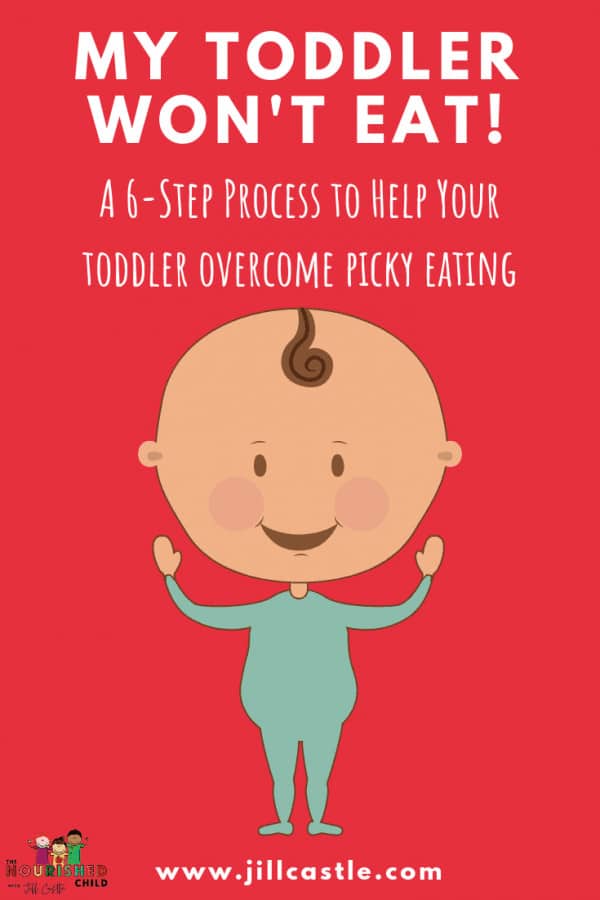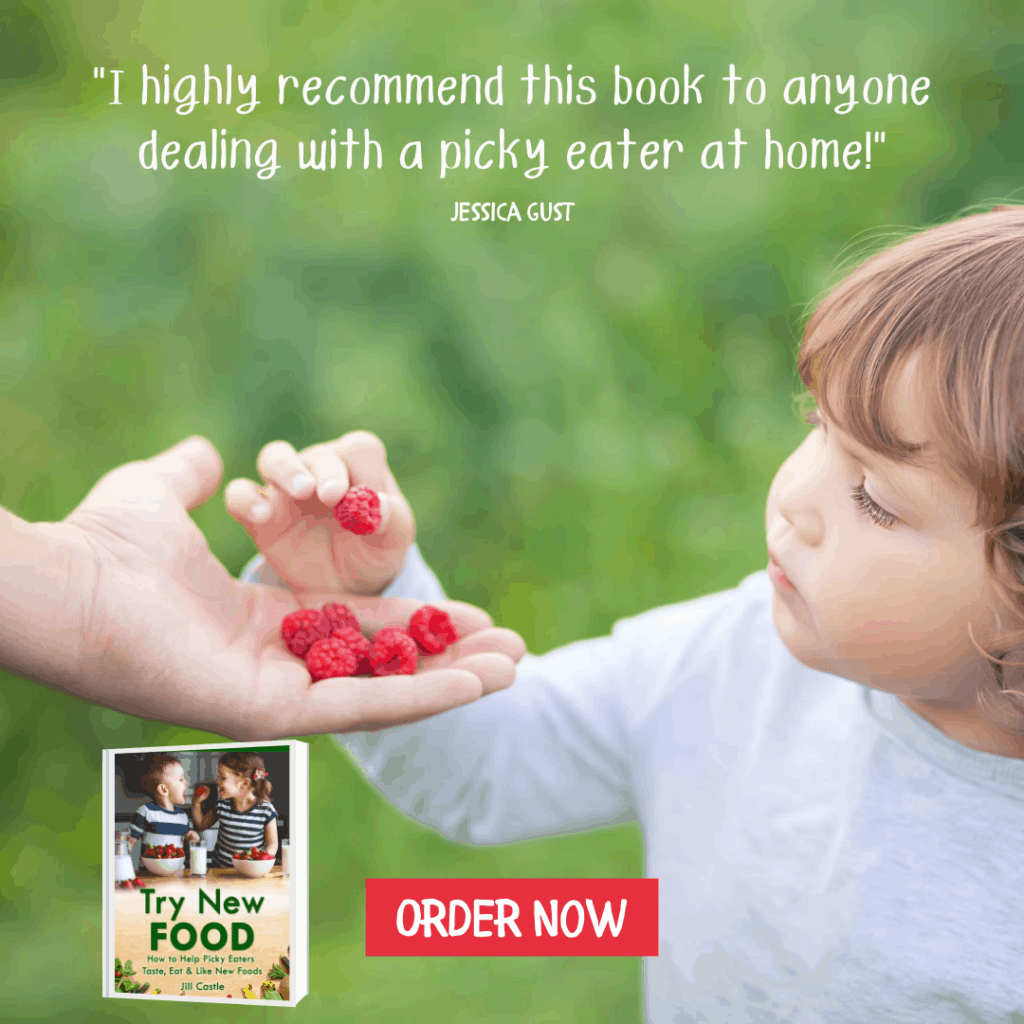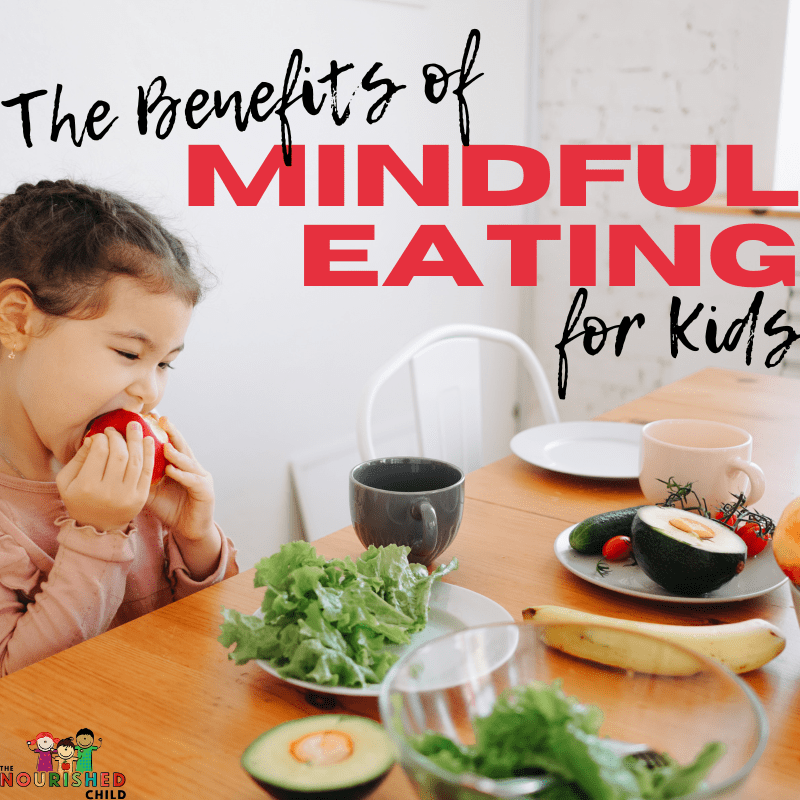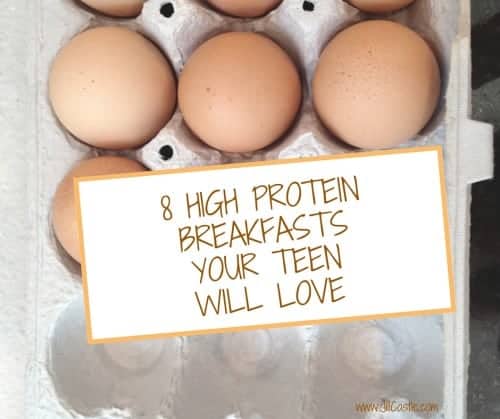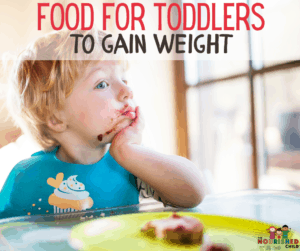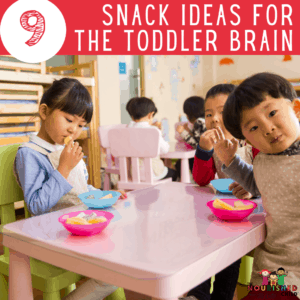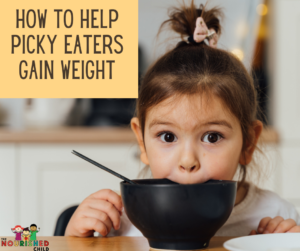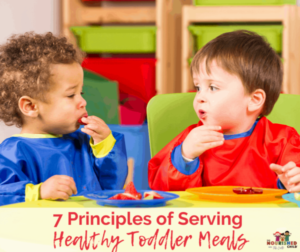Toddler Won’t Eat: What to Do When Your Child Refuses to Eat
September 10, 2022
Learn why your toddler isn’t eating and what you can do about it.
Toddlerhood can be a frustrating time for parents, especially when your toddler won’t eat.
As a pediatric nutritionist, I hear the details, the concerns and the hair-pulling frustration from so many parents.
And as a mom who’s been through it and seen the dark side of a picky toddler (hello, low weight and anemia!), I have a heart for parents who are worried and struggle with this.
I hope this article will help you feel calmer.
If you want to hear my story in detail, check out my TEDx talk.

Why is My Toddler Not Eating?
There are several reasons why toddlers change their eating patterns.
Often it seems to happen overnight and the worry for parents spikes.
Here are some examples of what some parents are experiencing:
“My toddler won’t eat dinner. He can barely sit still at the table and always wants to get down.”
“My son is 3 years old and won’t eat anything but snacks. The only meal I can get him to eat is pizza and milk. I’m so worried!”
“My toddler won’t eat dinner. Plus, she’s almost 3 and still won’t eat vegetables — even the few she was eating before.”
“My son is almost 2 and has suddenly stopped eating …what are the reasons a toddler won’t eat?”
“My 2 1/2 year old son will only eat a certain brand of chicken and French fries (of which I try to bake). Anything else he gags on…”
Sound familiar?
The consistent question Why won’t my toddler eat? is a good one.
Why do toddlers change so dramatically, going from avid eater to one that seems to care less about food and exist on next to nothing at all?
In this article, I’ll explore the main reasons your toddler won’t eat, and how you can help.
My step-by-step guide to toddler picky eating, developed from years of working with children and their families, will help you tackle this issue, so keep reading.
My Toddler Won’t Eat Anything…But Snacks…Or Milk
For toddlers, exploring the world, doing things for themselves and learning takes center-stage.
And this can certainly interfere with eating.
Picky eating during toddlerhood is a part of the toddler developmental trajectory for many children.
I think it’s pretty typical, however, it probably doesn’t feel very normal to you.
Any parent of a toddler will tell you, the days when their baby would eat anything, something I call the “Honeymoon Phase of Eating,” come to a halt, often immediately.
The toddler refuses to eat the foods he once loved.
He wants the same food day-in and day-out.
He won’t even try something new.
Some toddlers won’t eat anything but snacks.
Toddler food changes can be dramatic and sudden…and very frustrating for parents! But there are good reasons for this.
Let’s wander through the reasons.
1. Toddler Growth Slows Down
During toddlerhood, growth slows down compared to the quick clip of the first year of life when the body size increases two to three times its size from birth.
As growth slows the appetite follows, becoming less voracious than it once was.
Let me repeat, because this is an important concept: Growth and appetite are tightly woven together.
When growth slows, appetite slows.
When growth picks up, appetite picks up, too.
2. Toddlers are Curious Creatures
While growth and appetite are tapering off, toddlers are getting more curious about the world around them.
They want to separate from mom or dad and exert more independence.
That’s why they don’t want you to feed them any longer.
They want to do it themselves.
Toddlers are also figuring out how to have some control over their environment (and you!), while figuring out how to control themselves.
Ever notice how you have to help a toddler calm down from a temper tantrum?
It’s partly because they can’t control themselves yet.
As a parent, you may expect your little one’s eating will continue to go well. Just like infancy.
You may be shocked to see how differently your toddler eats compared to when she was a baby.
The truth is, most toddlers experience some dip in their eating, or at least some changes in their food preferences.
To ensure your growing toddler will continue to happily accept new foods, new textures and all the potential experiences with food, you’ll have to pay attention to a few things.
3. Negative Feeding Can Cause Toddler Refusal to Eat
If your toddler stops eating, your gut instinct may be to make eating happen.
You might even wonder HOW you can get the toddler to eat.
Whether you offer him what he likes to eat or make up a “rescue” meal, you take action.
Because what parent wants to worry about how much their kid ate, or whether he’ll sleep through the night?
When you take action, you may put pressure on your toddler to take another bite of food, encourage him to eat more, or you may even force feed your toddler to take bites of food by feeding him with a spoon.
What happens? Mealtimes get longer and longer and your child becomes less cooperative.
You see his joy of eating slipping away.
When you don’t trust your toddler and use tactics to make sure he eats, like pressuring him to eat, the feeding dynamic and parent-child interaction can get off track, causing your toddler to enjoy eating less and ultimately eat less food.
And you become more frustrated and worried.
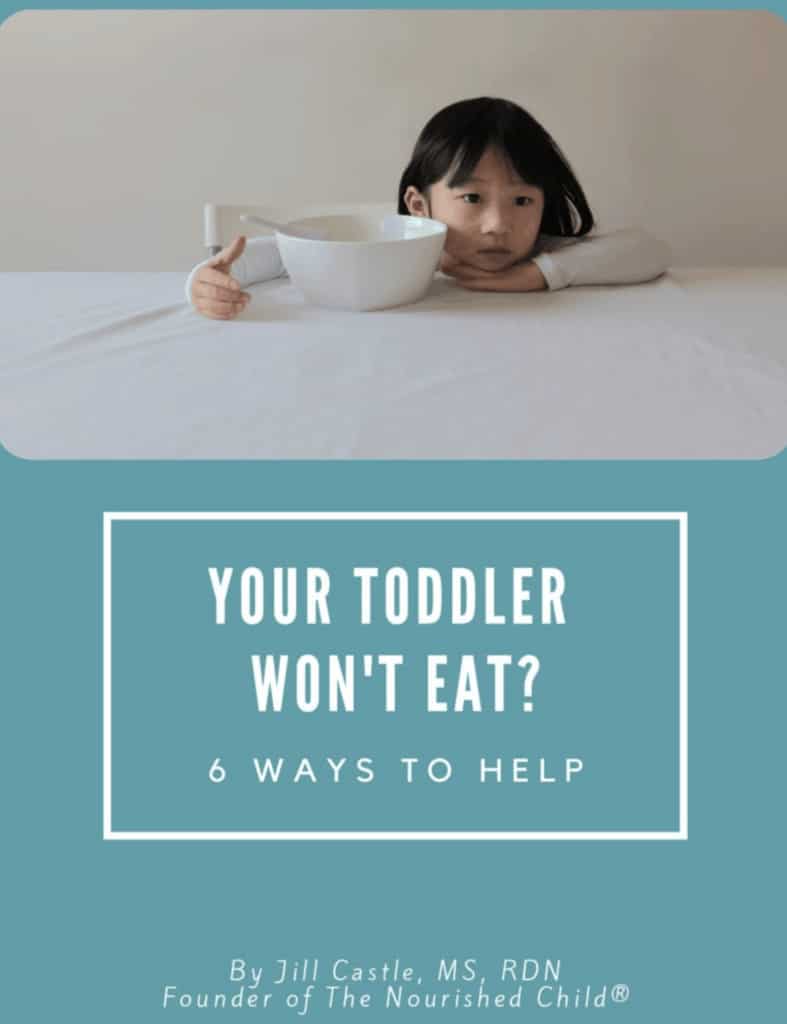
How to Get a Toddler to Eat
When parents ask me, “How do I get my picky toddler to eat?” I cringe a little on the inside.
I know that if your mindset is set on how to get your child to eat, you are probably engaging in some negative feeding tactics like the one I described above.
Parents do well to stay the course with food and feeding, following Ellyn Satter’s Division of Responsibility in Feeding, where you are in charge of what is on the menu, where and when eating happens, and your toddler is in charge of whether he eats and how much.
Your job isn’t to get your child to eat. It’s to offer nutritious, delicious meals at predictable times and in a usual location. When you’ve done that, your job is complete.
Easier said than done, right?!
Remember this: The more attention you bring to your toddler’s eating and the more you try to control, change it, or make it happen, the worse his eating can get.
Even worse?
You can prolong the picky eating phase for your toddler.
The more attention you bring to your toddler’s eating and the more you try to control, change it, or make it happen, the worse his eating can get. #pickyeating #pickyeater #feedingkids Click To TweetThere are lots of reasons why kids (of any age) won’t eat. I’ve covered the top 12 in this article.
How to Help When Your Picky Toddler Refuses to Eat [Step by Step]
First, if your toddler isn’t eating to your liking, make sure you know the 7 basic principles of healthy toddler meals.
This is a good place to begin.
Then, move through the following 6 steps.
These steps will help you set up a system that supports your toddler through this picky phase, while avoiding more eating problems down the road.
Step 1: Set up a Routine Schedule for Meals and Snacks
You’ll want to set an eating schedule during the day, planning for meals and snacks to happen at predictable times.
For toddlers, I like to see a 2-3 hour window between eating sessions and a total of five to six eating opportunities during the day.
Going longer than that can produce a toddler who is too hungry and increases the risk your toddler won’t be able to eat enough to meet his nutritional needs.
You know how toddlers can get when they’re starving — cranky, tantrum-prone and uncooperative.
No fun.
Sample Toddler Eating Schedule
Here’s an example of what a toddler eating schedule might look like:
6 am breakfast
8:30 am snack
11:00 am lunch
2 pm snack
5 pm dinner
7 pm snack
You’ll want your child’s meal and snack routine happening at roughly the same time day in and day out.
**meals should offer most food groups; snacks generally include two or more food groups, or could be a cup of milk**
For more on how to create a balanced meal for your toddler, read The Best Balanced Meal Plan for Kids.
Stumped about snacks and want to raise a Smart Snacker?
Check out my book, The Smart Mom’s Guide to Healthy Snacking.
Step 2: Create a Positive Feeding Relationship
Toddlers can be easily distracted and meal times are no different.
Go ahead and turn off the TV, put the toys away, shush the animals, and create a quiet environment so your toddler can give all of his attention to eating.
Pick a familiar location for meals and snacks, such as the kitchen and the highchair, or another regular place.
Make sure your toddler is comfortable in his seat and make toddler utensils (small utensils for small hands) available.
Sit with your child and pay attention to his eating signs that tell you when he is done.
Don’t pressure your toddler to eat or stop eating (see Step 5 below).
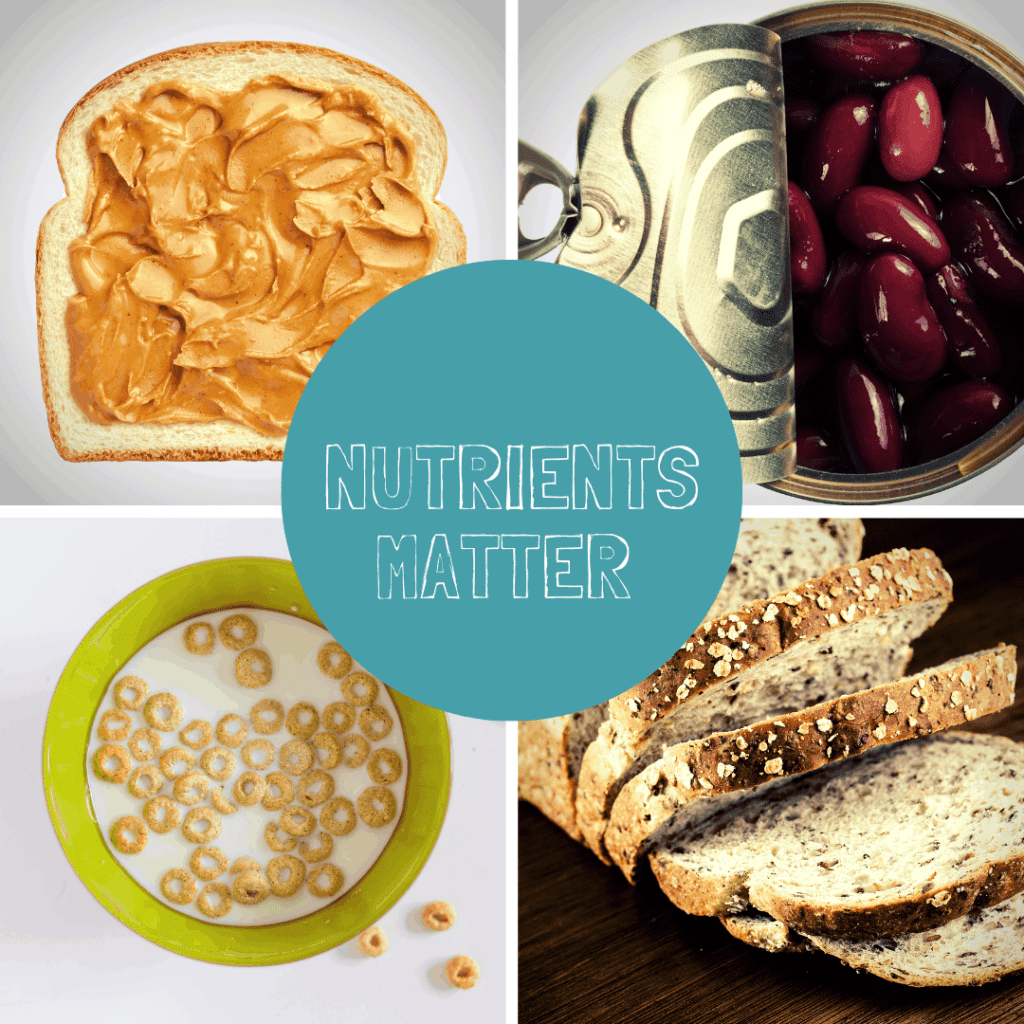
Step 3: Choose Healthy Foods & Encourage Trying New Foods
Toddlerhood is a time of food exploration.
Namely, you are offering a lot of different foods in order to help your toddler try new foods and expand his food variety and overall diet.
It is a time of learning and accumulating more foods in the diet.
- You’ll want to offer all the different food groups—grains, fruit, vegetable, protein, and dairy foods—throughout the day, and plan to include them at each meal.
- Include two or more food groups at snack time.
- Rotate items within the food groups to build variety. For example, rotate different fruits such as strawberries, peaches, banana, cut grapes, raisins, and so on.
Because “exploration” is the theme of toddlerhood, use this to your advantage.
Let your toddler explore food, get messy with it, and have some independence and autonomy with eating and choosing foods.
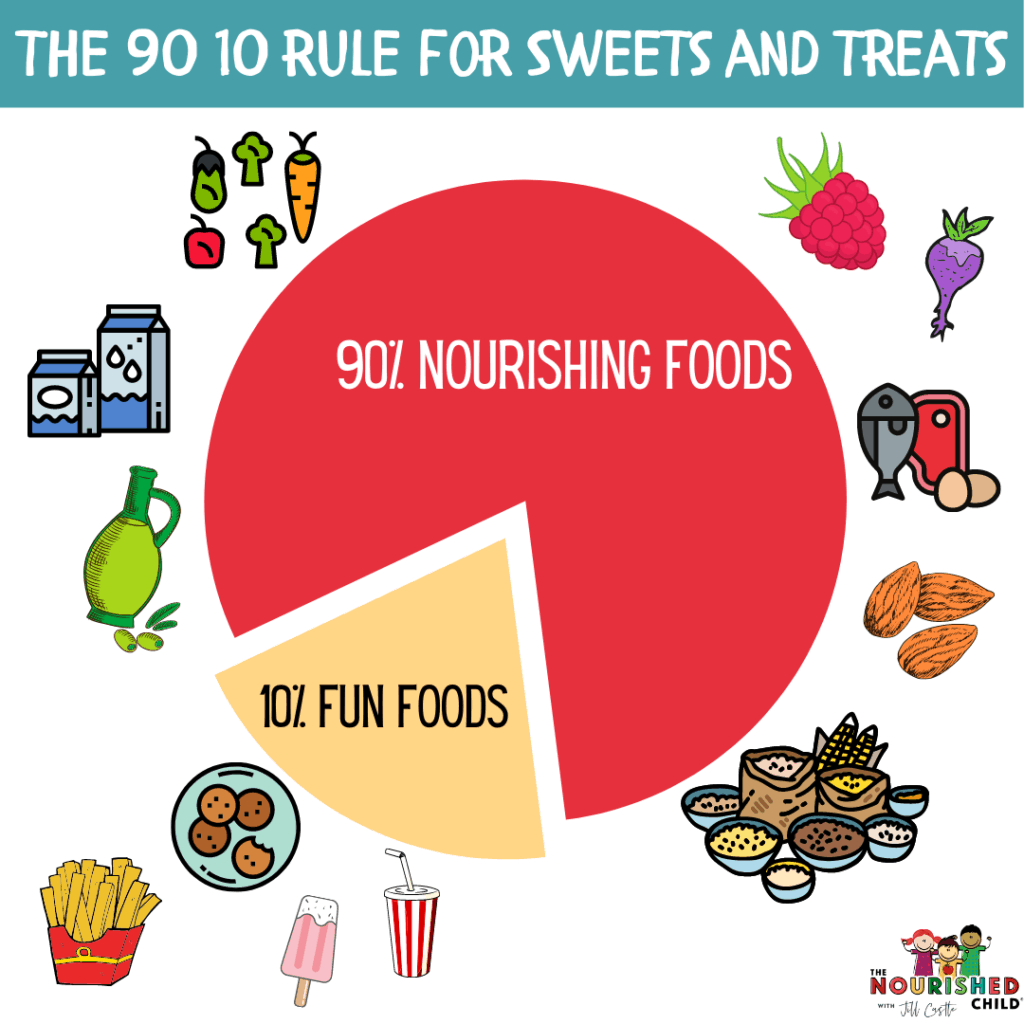
Food Portions for Toddlers
Generally, toddlers eat small portions of food when you compare it to what an adult would eat.
A toddler portion of food reflects his tummy size—it’s small.
My general advice is to start with a toddler portion.
Let your toddler ask for more food if he is hungry.
Some toddlers fill up on whole milk.
You’ll want to be careful with this as it can crowd out other important foods.
If your toddler is filling up on milk, he may not eat very well.
If your toddler drinks milk alternatives, you’ll want to pay more attention to other sources of protein, fat and nutrients in his diet.
You can always offer food first and reserve milk or other liquids for the end of the meal if this is an issue for your toddler.

Step 4: Pay Attention to Essential Nutrients
During toddlerhood, iron, zinc, calcium, vitamin D, and healthy fats like choline are important to the health and development of your toddler, as well as other nutrients.
Zinc is important for overall growth and keeping your toddler’s immunity in top form.
Iron helps keep your toddler’s brain growing and developing normally, while making sure he is energized.
Calcium and vitamin D help your toddler’s bones grow strong and hard.
Healthy fats like DHA make sure your toddler’s brain and body are growing well.
For the toddler, iron deficiency anemia, frequent illnesses, and rickets (a condition resulting in bowed legs) may be the result of nutrient deficiencies, so keep your eye on foods that help your toddler get enough of them.
Nutrient-Rich Foods for Toddlers
Zinc foods: meat, beans, ready-to-eat cereal, grains
Iron rich foods: red meat, dark leafy greens, dark meat poultry, soybeans, raisins
Calcium rich foods: milk, yogurt, cheese, fortified ready-to-eat cereals
Vitamin D foods: tuna canned in water, vitamin-D fortified orange juice, milk, eggs
Healthy fats: olive oil, avocado, seeds, nuts, fatty fish such as salmon
For more details on the nutrients your child needs, and an easy way to go about making sure he gets them from food, check out my Essential Nutrients for Kids Guidebook.
My book, The Calcium Handbook, can help with calcium and vitamin D food sources.
(click on this to get my downloadable guide)
Step 5: Build Trust in the Relationship: Use a Diplomatic Feeding Style
Your feeding style can get in the way of really raising a healthy eater!
As mentioned above, research tells us that too much pressure can make things worse, leading to less eating and prolonged picky eating.
Even too much praise can backfire!
Not only does pressure interfere with your toddler’s eating, rewarding your child with dessert, taking away food, and short-order cooking (making your child what he will eat) also complicates eating for your child.
It’s best to keep a neutral disposition when feeding young children.
Remember, the goal is not to get your child to eat but to provide opportunities to taste, eat and explore food without negative interactions.
Yes, I know that the eating habits of your toddler may be less than satisfying to you, but there are things that help and things that don’t help.
Get more insight on parenting food, as it’s an essential foundation of knowledge.
It’s helpful to children when you:
- Provide regular meals and snacks
- Offer nutritious combinations of food
- Let your child decide whether he is eating what you offered or not
- Close the kitchen after meals and snacks
- Remain calm no matter how badly your toddler is behaving
It’s not helpful for children when you:
- Get mad, frustrated or upset in front of your toddler
- Pressure your toddler to eat
- Bribe or negotiate over food
- Reward your toddler with dessert in exchange for eating or trying something new
- Punish your toddler for not eating
- Force your toddler to eat
Want to do a self-assessment of your feeding style? Snag my feeding style comparison guide.
Step 6: When Should I Call the Doctor?
Some toddlers will get stuck in the “not eating” phase, and may need more help.
If your toddler is going days without eating, you need to see the pediatrician and make sure your toddler isn’t losing weight or in immediate danger of dehydration.
My Toddler Won’t Eat Anything But Snacks
It’s easy to fall into the snack trap, and allowing your toddler to graze throughout the day.
For one, this isn’t teaching good eating habits, but more importantly, it’s probably interfering with appetite regulation.
Try to carve out regular meal times and bring your toddler to the table.
Don’t force him to eat, but try to keep a positive vibe and train your toddler to sit for 10 minutes.
It might take some practice, but sitting for a bit will encourage your toddler to explore the meal.
At snack time, bring your toddler to the table and keep the distractions low.
Just having your toddler sit down for snacks will minimize grazing all day.
My Toddler is Underweight
This happened to my toddler.
My daughter stopped gaining weight and eventually fell off her growth chart.
If you’re in a similar situation, don’t panic.
If your toddler isn’t growing well or is underweight, you may need to talk with your pediatrician about seeing a dietitian who works with kids to make sure your child is getting the nutrition he needs.
What If My Toddler is Choking?
If your child is choking or gagging a lot when eating, this can be unpleasant – even negative – for her.
Seek additional help in this case. You may need to get a feeding evaluation.
Prolonged negative experiences can cause aversion which can lead to more problems down the road.
An evaluation will help you learn if there is more going on, such as a mechanical issue in the mouth, sensory sensitivities that interfere with trying new food, ARFID, or other medical factors.
My Toddler Won’t Eat Anything But Milk
The biggest danger to a toddler who won’t eat anything but milk is iron deficiency.
Calcium binds up iron, making it difficult for the body to absorb it.
Also, milk is very filling and may reduce your toddler’s appetite for other foods.
If your toddler is guzzling milk all day long, it’s time to limit milk to mealtimes or between meals.
Cut back to 2 – 2 1/2 cups total for the day (you can offer 1/2 cup or more at a time, for instance).
Read more about toddler portion sizes!
Toddler Doesn’t Want to Eat Meat
Meats are rich in iron, zinc and vitamin B12, as well as other important nutrients.
They can be a useful, nutritious part of the toddler diet.
However, meat can be challenging for your toddler to eat. For one, it’s generally tough and chewy.
Since young toddlers are still learning to fine tune their eating skills, some may find it hard to chew meat and just give up.
How you prepare meat can make the difference!
- Offer ground meats, like beef or turkey.
- Choose tender cuts of meat like the dark meat of turkey or chicken.
- Prepare meat with a slow cooker, instant pot, or other tenderizing ways to prepare meats. This will yield a tender, easy-to-chew meat.
My Toddler Won’t Eat Vegetables
It’s not uncommon for toddlers to skip their veggies. The biggest reason for this is that vegetables are bitter.
Let’s just say they’re an “acquired taste.”
Which means your toddler needs frequent exposure to them in order to develop a taste and preference for them.
So keep offering them…even though your toddler may not eat them.
In the meantime, serve fruit alongside vegetables. While they’re not a perfect match, nutrient-wise, they are pretty close.
You can rest assured your toddler is getting similar nutrients from fruit, while getting the exposure they need to start developing a preference for vegetables.
My Toddler Isn’t Eating and Is Losing Weight
It’s normal for your toddler to thin out between ages two and five. This phenomenon is called “adiposity rebound.”
It’s the time when all that baby fat that was gained in the first year is redistributed and your toddler gets taller.
It’s normal.
You don’t need to “fatten up” your toddler.
In fact, research shows when toddlers don’t experience this thinning out, they’re at higher risk for excess body fat later on in childhood.
However, if you notice your toddler’s losing weight and it seems significant, it’s time to go check in with your pediatrician.
You may get the message that your toddler is growing fine – your doctor can see this on the growth chart.
What do you do when your toddler won’t eat?
More Help for the Toddler Refusing to Eat
If you’re in over your head, you may need to dig into a more positive and productive way of feeding your child.
My 6-Step Guide will certainly get you started, but if you want to really transform HOW to offer and interact around new food and a picky eater, get my workbook, Try New Food: How to Help Picky Eaters Taste, Eat, & Like New Food!
It takes you through all the steps to nourish and feed your toddler when picky, and even when older and extremely picky.
Be sure to check out The Ultimate Guide to Feeding the Picky Eater!
Or, if you want to learn more about nourishing your child as he grows, check out my online program, The Nourished Child Blueprint.
You’ll learn how to set up a food system in your home, a diplomatic feeding style, and establish the healthy habits your child will need to grow up healthy — in the comfort of your own home!

This post was updated in September 2022.

